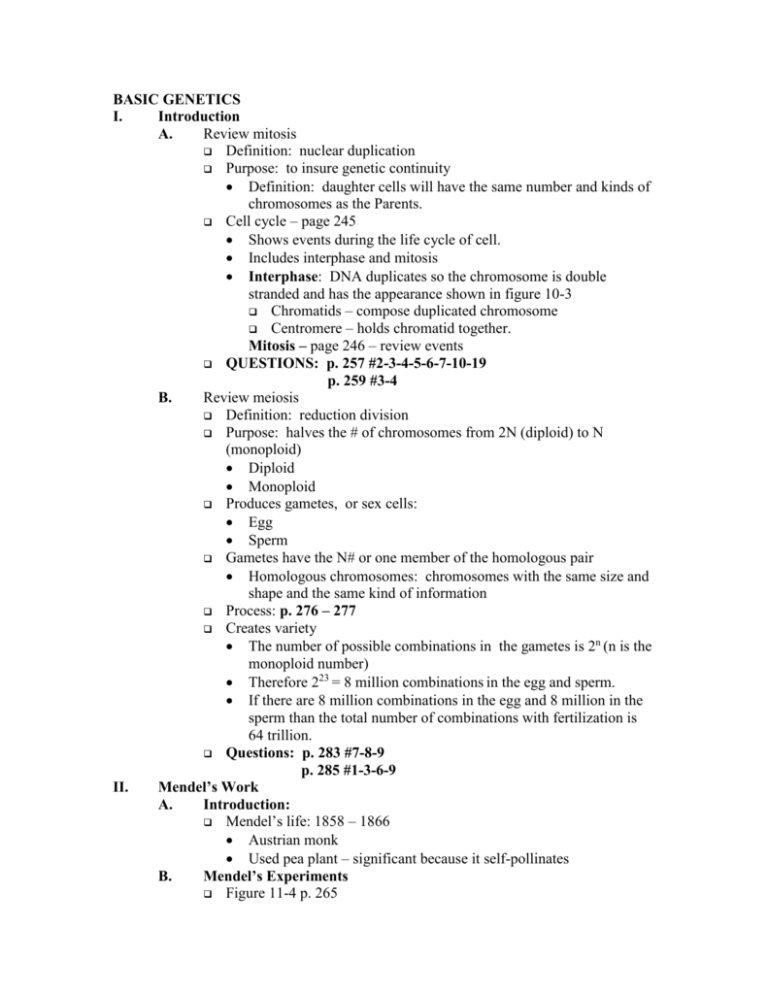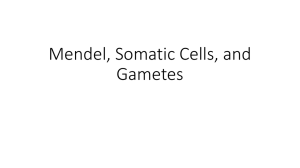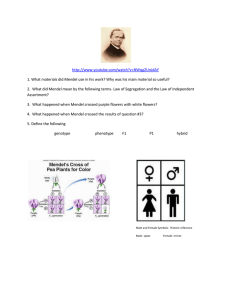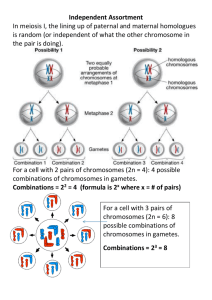BASIC GENETICS
advertisement

BASIC GENETICS I. Introduction A. Review mitosis Definition: nuclear duplication Purpose: to insure genetic continuity Definition: daughter cells will have the same number and kinds of chromosomes as the Parents. Cell cycle – page 245 Shows events during the life cycle of cell. Includes interphase and mitosis Interphase: DNA duplicates so the chromosome is double stranded and has the appearance shown in figure 10-3 Chromatids – compose duplicated chromosome Centromere – holds chromatid together. Mitosis – page 246 – review events QUESTIONS: p. 257 #2-3-4-5-6-7-10-19 p. 259 #3-4 B. Review meiosis Definition: reduction division Purpose: halves the # of chromosomes from 2N (diploid) to N (monoploid) Diploid Monoploid Produces gametes, or sex cells: Egg Sperm Gametes have the N# or one member of the homologous pair Homologous chromosomes: chromosomes with the same size and shape and the same kind of information Process: p. 276 – 277 Creates variety The number of possible combinations in the gametes is 2n (n is the monoploid number) Therefore 223 = 8 million combinations in the egg and sperm. If there are 8 million combinations in the egg and 8 million in the sperm than the total number of combinations with fertilization is 64 trillion. Questions: p. 283 #7-8-9 p. 285 #1-3-6-9 II. Mendel’s Work A. Introduction: Mendel’s life: 1858 – 1866 Austrian monk Used pea plant – significant because it self-pollinates B. Mendel’s Experiments Figure 11-4 p. 265 Production of monohybrid 1. Definition: produced from two dissimilar parents 2. Significance of results: showed the Law of Dominance Dominant Recessive C. Mendel’s Hypothesis Page 266 – Law of Segregation 1. proved with test cross Terms: Homozygous Heterozygous Phenotype Genotype Alleles Punnett Square D. Mendel’s Dihybrid Cross Page 270 – figure 11-9 Page 271 – figure 11-10 Proved Law of Independent Assortment Continuous Variation A. Definition – varying degrees of a characteristic B. Examples: quantitative traits such as height and skin tone C. Explained by multiple genes or polygenic inheritance Traits controlled by two or more genes Incomplete Dominance A. Definition – the heterozygous condition results in an intermediate trait B. Examples: figure 11-11 p. 272 III. IV. Review: p. 283 #13-17 p. 285 #2-4











